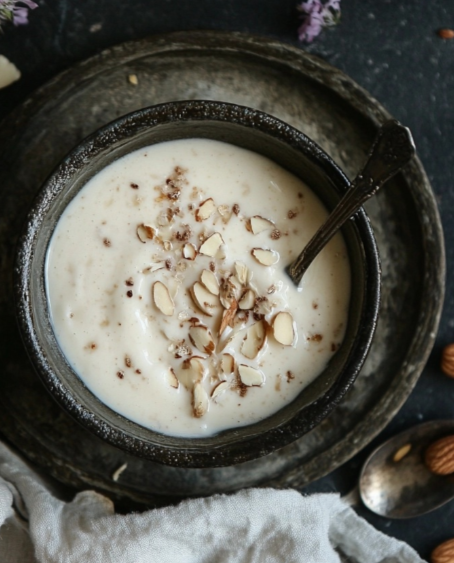Silk Almond Milk has become a go-to dairy alternative for health-conscious individuals, vegans, and those with lactose intolerance. But have you ever wondered, what is Silk Almond Milk made of? This plant-based milk isn’t just blended almonds and water—it’s carefully crafted with added nutrients, natural ingredients, and a smooth texture that makes it a versatile choice for drinking, cooking, and even coffee. In this guide, we’ll break down its ingredients, how it’s made, and why it has become one of the most popular non-dairy milk options today.
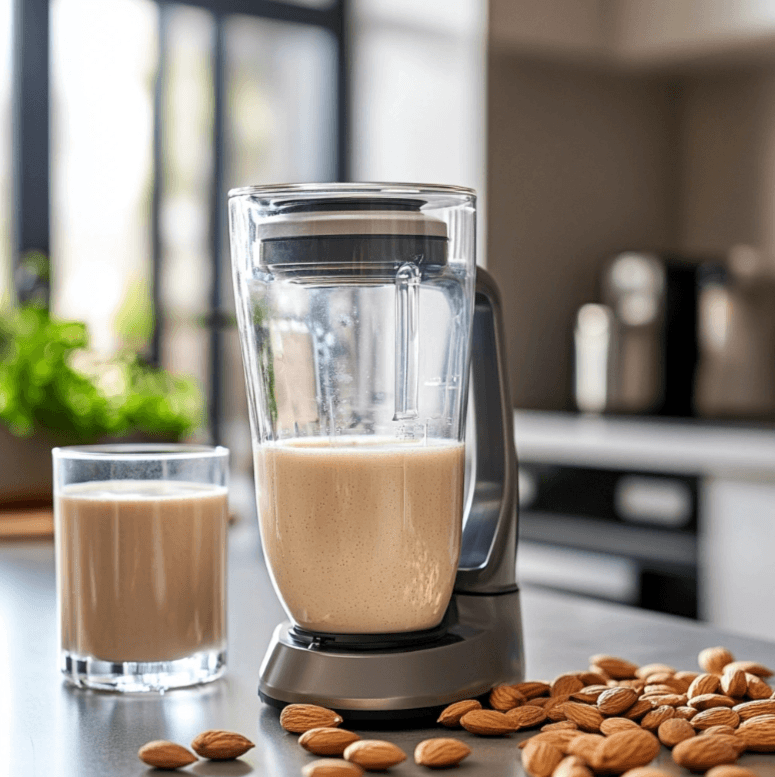
Table of Contents
The Rise of Plant-Based Milks
Once upon a time, the only milk option was cow’s milk. But today? Supermarket shelves are packed with plant-based milk alternatives—almond, oat, soy, coconut, cashew… the list goes on! One of the biggest names in the game? Silk Almond Milk.
People are switching to almond milk for a variety of reasons—lactose intolerance, health benefits, ethical concerns, or simply personal preference. But many wonder: What is Silk Almond Milk actually made of? Is it just almonds and water, or is there more to it? 🤔 Let’s find out!
Understanding Almond Milk: A Popular Dairy Alternative
What Is Almond Milk?
Almond milk is a creamy, dairy-free beverage made by blending almonds with water and straining out the solids. It’s a popular choice for vegans, people with lactose intolerance, and those looking for a healthier milk alternative.
Many people even make almond milk at home by soaking almonds, blending them with water, and straining the mixture. But commercial brands—like Silk—take things a step further to create a longer-lasting, nutrient-fortified product.
The Popularity of Silk Almond Milk
Silk is one of the most trusted brands in the plant-based milk industry. They started with soy milk and eventually expanded into almond, oat, and cashew milk. What makes Silk Almond Milk stand out?
✔ Rich, creamy texture – Unlike some watery almond milks, Silk has a smooth, well-balanced consistency.
✔ Fortified with essential nutrients – It contains calcium, vitamin D, and B12 to support bone and immune health.
✔ Diverse flavors – Available in Original, Unsweetened, Vanilla, and even Chocolate! 🍫
Fun Fact: Many people assume almond milk is naturally high in calcium, but Silk fortifies its almond milk with more calcium than dairy milk! 🥛💪
If you enjoy plant-based recipes, you might also love our Creamy Cauliflower Soup with White Cheddar—a perfect dish to pair with almond milk!
Silk Almond Milk Ingredients: A Breakdown
So, what’s actually in Silk Almond Milk? Here’s a breakdown of the key ingredients and their purpose:
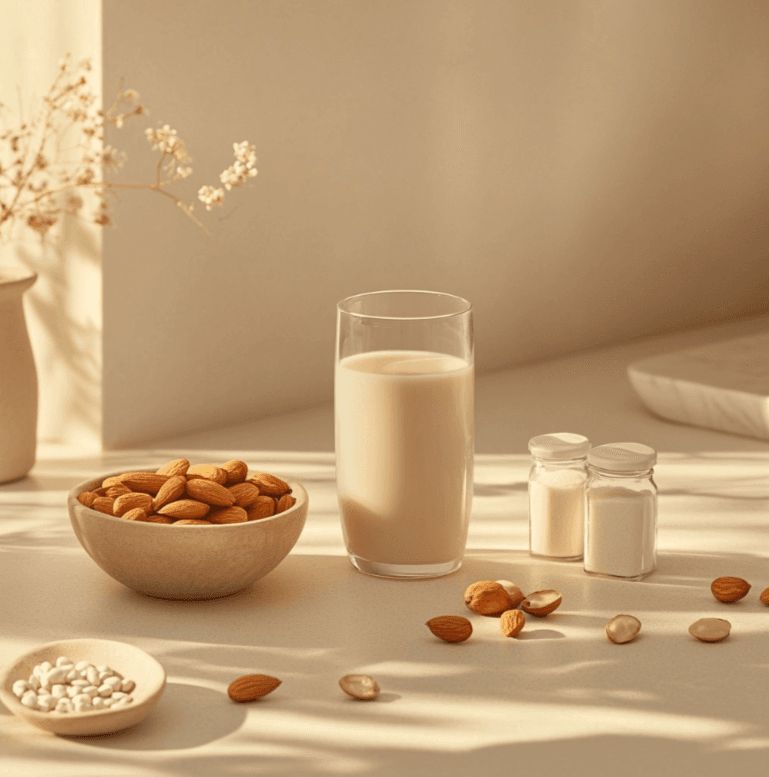
| Ingredient | Purpose |
|---|---|
| Almonds | The base of the milk, providing a nutty flavor and nutrients |
| Water | The primary liquid, used to blend and extract almond essence |
| Calcium Carbonate | Added for bone health, making it similar to dairy milk |
| Vitamin D2 | Essential for calcium absorption and bone strength |
| Vitamin B12 | Important for energy and red blood cell formation |
| Sunflower Lecithin | Helps mix water and almonds for a smooth texture |
| Gellan Gum | A thickening agent that keeps the milk from separating |
| Natural Flavors | Enhances taste, especially in vanilla or chocolate varieties |
How These Ingredients Affect Taste and Texture
If you’ve ever made homemade almond milk, you know it tends to be thin and separates quickly. That’s because it lacks stabilizers like gellan gum and sunflower lecithin, which help commercial almond milk maintain a smooth and consistent texture.
✔ Gellan gum prevents the milk from separating.
✔ Sunflower lecithin improves creaminess.
✔ Calcium, Vitamin D, and B12 are added to boost nutritional value.
Did you know? A cup of Silk Almond Milk contains more calcium than dairy milk—a huge bonus for those following a plant-based diet!
Additives and Preservatives: Are They Safe?
Some people worry about additives in almond milk, but here’s the good news:
✔ No artificial preservatives – Silk uses heat pasteurization to keep the milk fresh.
✔ No carrageenan – Some brands use carrageenan (a controversial thickener), but Silk does not!
✔ All additives are plant-based and safe for consumption.
“If you’re looking for an even cleaner option, try Silk Unsweetened Almond Milk, which contains fewer ingredients but still delivers great taste!”
How Is Silk Almond Milk Made? – Step-by-Step Process
Ever wondered how Silk Almond Milk is made on a large scale? Here’s a step-by-step breakdown of the process:
Sourcing and Selecting the Almonds
Silk sources high-quality, non-GMO almonds, primarily from California, where almonds grow best. These almonds are selected based on strict quality control to ensure freshness and flavor.
Blending and Straining: Extracting Almond Milk
1️⃣ Soaking: Almonds are soaked in water to soften them and bring out their natural flavors.
2️⃣ Blending: The almonds are blended with fresh water to create a smooth almond mixture.
3️⃣ Straining: The mixture is passed through a fine filter to remove any solid almond pulp, leaving behind a pure, creamy liquid.
Fortification: Adding Vitamins and Nutrients
Unlike dairy milk, almond milk lacks natural calcium and vitamin D. To make it a suitable replacement, Silk fortifies its almond milk with:
- Calcium Carbonate – Supports strong bones.
- Vitamin D2 – Helps with calcium absorption.
- Vitamin B12 – Essential for red blood cell production (especially important for vegans!).
Pasteurization and Packaging for Shelf Stability
- The almond milk is heat-pasteurized to kill bacteria and extend its shelf life.
- It’s then packaged in aseptic (sterile) cartons or bottles, which keep it fresh for months without refrigeration before opening.
“Ever wondered how homemade almond milk compares? If you’re looking for a simple plant-based recipe to try, don’t miss our Ultimate Guide to the Perfect Smoked Salmon Dip—a dairy-free dip that pairs wonderfully with almond milk alternatives!”
Nutritional Value of Silk Almond Milk
Wondering how Silk Almond Milk stacks up nutritionally? Here’s a quick comparison to dairy milk:
| Nutrient | Silk Almond Milk (per 1 cup) | Cow’s Milk (per 1 cup) |
|---|---|---|
| Calories | 30-60 (depending on variety) | ~150 |
| Protein | 1g | 8g |
| Fat | 2.5g | 8g |
| Carbohydrates | 1g | 12g |
| Calcium | 450mg | 300mg |
| Vitamin D | 2.5mcg | 2.9mcg |
| Vitamin B12 | 1.2mcg | 1.1mcg |
Comparing Silk Almond Milk to Dairy Milk
✔ Lower in calories – A great choice for those watching their weight.
✔ Less protein – Unlike cow’s milk, almond milk isn’t a protein powerhouse.
✔ Higher in calcium – Fortification ensures it has more calcium than regular milk.
✔ Lactose-free and plant-based – Ideal for people with lactose intolerance or those following a vegan diet.
Looking for more plant-based meal ideas? Check out our guide to Mediterranean Chickpea Salad with Feta! 🥗
Common Problems with Almond Milk
Silk Almond Milk is a fantastic dairy alternative, but it comes with a few quirks. Some people experience issues with separation, cooking performance, or spoilage. Let’s go over the most common problems and how to fix them!
Why Does Almond Milk Separate?
Ever poured a glass of almond milk only to find weird layers forming? Don’t worry—it’s completely normal!
Silk Almond Milk contains gellan gum and sunflower lecithin to help prevent separation, but since it’s made mostly of water and almonds, some natural separation can still happen.
✔ Solution:
- Always shake the carton before drinking.
- Keep it refrigerated at a stable temperature.
- Avoid exposing it to extreme temperatures, which can cause faster separation.
Pro Tip: If your almond milk curdles in coffee, warm it slightly before adding it to avoid temperature shock! ☕
Can You Cook and Bake with Silk Almond Milk?
Yes! But not all recipes react the same way to almond milk as they do to dairy milk.
Works Great For:
✔ Baking cakes, cookies, and muffins – Use it as a 1:1 substitute for dairy milk.
✔ Smoothies and shakes – Adds a mild, nutty flavor.
✔ Oatmeal and cereals – Makes them creamy and delicious.
What’s Tricky?
⚠ Creamy sauces and custards – Almond milk is thinner than dairy, so sauces might not be as rich.
⚠ Frothing for lattes – It doesn’t froth like cow’s milk, but Silk Barista Almond Milk is a great alternative for coffee lovers.
Need a thicker texture? Use Silk Almond Creamer instead of regular almond milk when making soups, sauces, or coffee.
Does Silk Almond Milk Go Bad? How to Store It Properly
Like all plant-based milks, Silk Almond Milk can spoil, but its shelf life is longer than fresh dairy milk.
Shelf-Stable vs. Refrigerated Varieties
- Shelf-stable cartons (found in the dry grocery aisle) can last months if unopened.
- Refrigerated Silk Almond Milk should be consumed within 7-10 days after opening.
How to Tell If It’s Gone Bad
🚩 Sour smell or an off-putting odor.
🚩 Lumpy or curdled texture.
🚩 Strange, unpleasant taste.
✔ Solution:
- Always store it in the fridge after opening.
- Keep the cap sealed tightly to prevent bacteria from getting in.
- Check the expiration date before drinking!
Is Silk Almond Milk Healthy? – The Pros and Cons
Silk Almond Milk is promoted as a healthy, dairy-free alternative, but is it actually good for you? Let’s look at the benefits and downsides.
Health Benefits: Why People Choose Almond Milk
✅ Low in Calories – The unsweetened version has only 30 calories per cup, making it a great choice for weight loss.
✅ Rich in Vitamins & Minerals – Thanks to fortification, Silk Almond Milk contains:
- More calcium than dairy milk.
- Vitamin D for strong bones.
- Vitamin B12, essential for vegans.
✅ Lactose-Free & Vegan – Perfect for those with dairy allergies, lactose intolerance, or plant-based diets.
✅ Good for Digestion – Almond milk is easier on the stomach than dairy, which can cause bloating for some people.
Potential Downsides and Who Should Avoid It
🚫 Low in Protein – Regular Silk Almond Milk only has 1g of protein per cup, while cow’s milk has 8g. If you need more protein, try Silk Protein Almond & Cashew Milk (10g per cup).
🚫 Contains Added Ingredients – While Silk avoids harmful additives, it does contain gums and stabilizers (like gellan gum) to improve texture.
🚫 Not Suitable for Nut Allergies – If you have a nut allergy, almond milk is not safe—consider Silk Soy or Oat Milk instead.
If you’re considering Silk Almond Milk for a healthier diet, you might also be interested in our breakdown of another creamy dish: Sweet Potato and Black Bean Enchiladas—a delicious, plant-based meal!
Looking for a high-protein alternative? Try Silk Protein Almond & Cashew Milk, which has 10g of protein per cup!
Comparing Silk Almond Milk to Other Milk Alternatives
Silk Almond Milk isn’t the only plant-based milk out there. How does it compare to other popular options?
| Milk Type | Calories (per cup) | Protein | Best For |
|---|---|---|---|
| Silk Almond Milk | 30-60 | 1g | Smoothies, cereals, baking |
| Silk Oat Milk | 120 | 2g | Lattes, coffee, creamy sauces |
| Silk Soy Milk | 100 | 7g | Cooking, protein needs |
| Cashew Milk | 40-50 | <1g | Sauces, creamy desserts |
| Coconut Milk | 50 | <1g | Curries, tropical flavors |
Silk Almond Milk vs. Regular Almond Milk
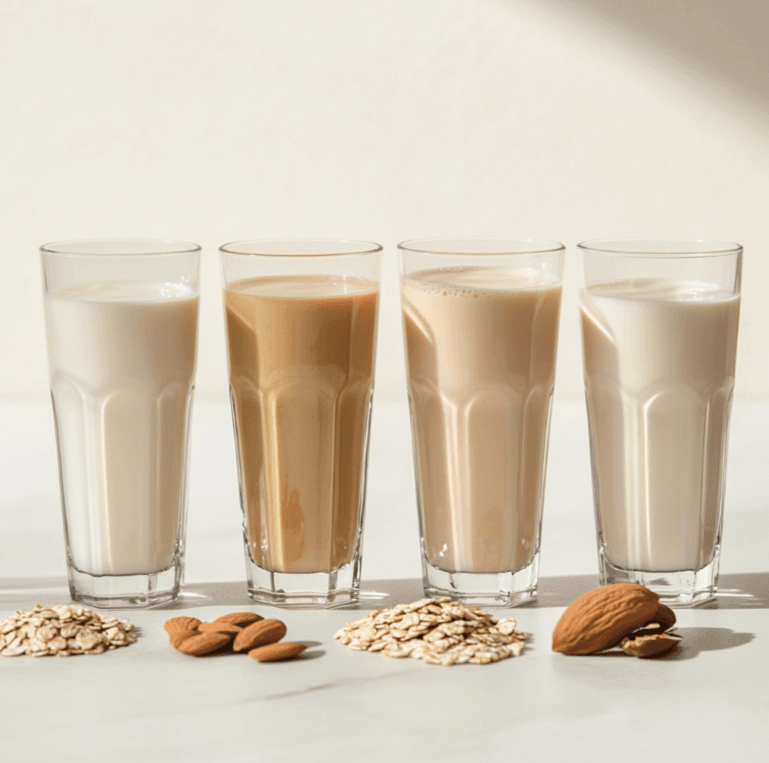
- Silk Almond Milk is fortified with vitamins and minerals, unlike many generic almond milk brands.
- Silk’s texture is smoother due to stabilizers, while homemade or other brands might separate more easily.
- Unsweetened Silk Almond Milk is one of the lowest-calorie options available.
Silk Almond Milk vs. Oat Milk
- Oat milk is creamier, making it better for lattes and coffee.
- Almond milk is lower in calories and carbs, which is great for weight management.
- Oat milk has natural sweetness, while almond milk is more neutral.
Silk Almond Milk vs. Soy Milk
- Soy milk has more protein (closer to dairy milk in nutrition).
- Almond milk is lighter and lower in calories.
- Soy milk has a stronger “beany” flavor, while almond milk is mild and nutty.
Want a plant-based milk that froths like dairy? Try Silk Oat Milk Barista Edition—it’s perfect for coffee lovers! ☕
Is Silk Almond Milk Environmentally Friendly?
Many people choose plant-based milk not just for health reasons but also because they want a more sustainable option. But how does Silk Almond Milk compare to dairy in terms of its environmental impact?
Water Usage and Sustainability of Almond Farming
One of the biggest criticisms of almond milk is the amount of water needed to grow almonds. It takes around 1.1 gallons of water to grow a single almond, and since almond milk production requires thousands of almonds, the water footprint can be high.
However, when compared to dairy milk, almond milk still comes out ahead.
| Milk Type | Gallons of Water per 1 Cup of Milk |
|---|---|
| Dairy Milk | 120 gallons |
| Almond Milk | 23 gallons |
| Oat Milk | 6 gallons |
| Soy Milk | 15 gallons |
✔ Silk is working to improve sustainability by supporting water-efficient farming methods and sourcing non-GMO almonds responsibly.
Did you know? Dairy farming requires significantly more water than almond milk production and produces large amounts of methane gas, a leading contributor to climate change.
Packaging and Carbon Footprint
Silk uses aseptic cartons, which are recyclable and reduce the need for refrigeration during transport. This lowers the carbon footprint compared to plastic bottles.
However, not all parts of the carton are biodegradable, so recycling facilities must process them properly.
✔ How You Can Reduce Your Impact:
- Choose cartons over plastic bottles when possible.
- Recycle cartons in the proper waste bins.
- Opt for unsweetened varieties—less processing means a lower footprint!
“For an even greener choice, you might consider homemade almond milk or switching to oat milk, which has a lower water usage footprint.“
How to Choose the Best Almond Milk for Your Needs
Not all almond milks are created equal! Depending on your health goals, taste preference, and dietary needs, here’s how to pick the best one.
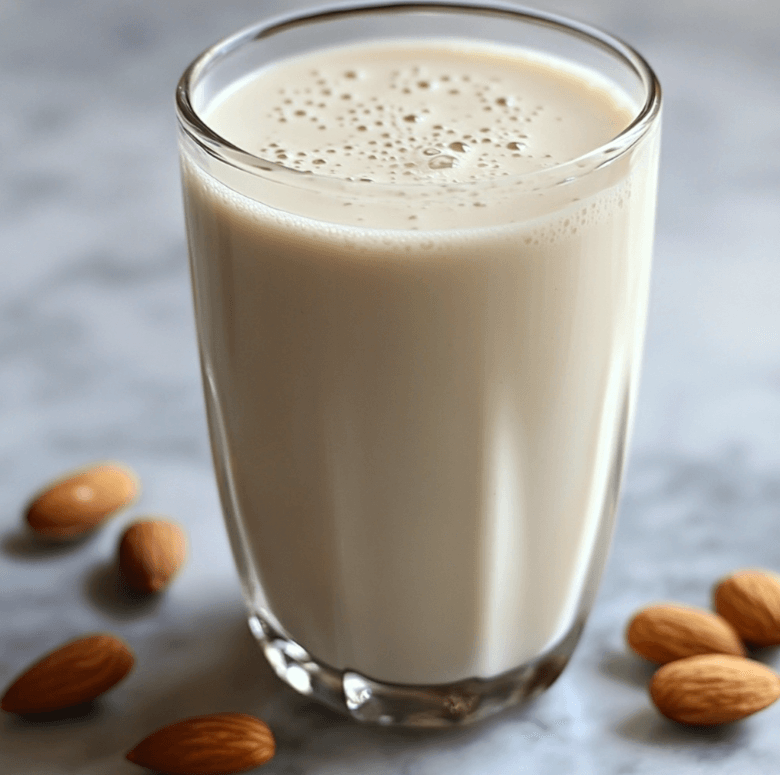
Sweetened vs. Unsweetened Silk Almond Milk
| Type | Calories (per cup) | Sugar Content | Best For |
|---|---|---|---|
| Unsweetened Almond Milk | 30 | 0g | Weight loss, keto, low-carb diets |
| Original Almond Milk | 60 | 7g | Balanced taste with a little sweetness |
| Vanilla Almond Milk | 80 | 9g | Coffee, smoothies, desserts |
| Chocolate Almond Milk | 90 | 12g | Sweet treats, chocolate lovers 🍫 |
✔ Go for unsweetened if you’re watching calories or sugar intake.
✔ Choose vanilla or chocolate for a more flavorful option.
Original vs. Vanilla and Chocolate Flavors
- Original Almond Milk – Neutral taste, best for cooking, cereal, and coffee.
- Vanilla Almond Milk – A touch of sweetness, perfect for smoothies and baking.
- Chocolate Almond Milk – Great for kids and sweet cravings! 🍫
Need an almond milk for coffee? Try Silk Almond Creamer, which is richer and creamier than regular almond milk! ☕
Silk Almond Creamer: A Better Alternative for Coffee?
If regular almond milk is too thin for your coffee, Silk’s Almond Creamer is a thicker, richer alternative.
✔ Froths better than regular almond milk.
✔ Comes in Vanilla, Caramel, and Hazelnut flavors.
✔ Lower in calories than heavy cream or dairy-based creamers.
“If you’re a coffee lover, Silk Almond Creamer could be your new best friend! ☕”
DIY Almond Milk vs. Store-Bought Silk Almond Milk
Some people prefer homemade almond milk because it’s 100% natural and free from additives. But is it really better than Silk Almond Milk? Let’s compare.
| Feature | Homemade Almond Milk | Silk Almond Milk |
|---|---|---|
| Ingredients | Just almonds & water | Fortified with vitamins & minerals |
| Shelf Life | 3-5 days | 7-10 days (refrigerated), months (shelf-stable) |
| Texture | Can be grainy | Smooth and creamy |
| Nutrient Content | Lacks calcium & vitamins | Fortified for better nutrition |
| Convenience | Requires soaking, blending, straining | Ready-to-drink |
Pros and Cons of Homemade vs. Silk Almond Milk
Homemade:
✅ No additives or stabilizers
✅ Full control over ingredients
❌ Short shelf life
❌ Lacks calcium and other nutrients
Silk Almond Milk:
✅ Longer shelf life
✅ Fortified with essential vitamins and minerals
❌ Contains stabilizers (though safe and plant-based)
“If you’re looking for convenience and nutrition, Silk Almond Milk is the better choice. But if you prefer natural, no-additive options, homemade almond milk is a great alternative!”
Frequently Asked Questions About Silk Almond Milk
Can You Froth Silk Almond Milk for Lattes?
Yes, but regular Silk Almond Milk doesn’t froth as well as dairy milk. Silk Barista Almond Milk is specially designed to create better foam and texture for lattes.
Is Silk Almond Milk Safe for Toddlers and Babies?
🚨 No! Almond milk, including Silk, is not a suitable replacement for infant formula or breast milk. However, toddlers over one year old can drink it as part of a balanced diet.
Does Silk Almond Milk Contain Gluten or GMOs?
Nope! Silk Almond Milk is gluten-free and non-GMO, making it safe for people with dietary restrictions.
“Looking for more gluten-free recipes? Check out our Gluten-Free Rice Cereal Treats Guide! 🍚”
What Happens If You Drink Expired Almond Milk?
🚫 Don’t risk it! Expired almond milk can contain harmful bacteria, leading to food poisoning symptoms like nausea and stomach cramps.
✔ Always check the expiration date.
✔ If it smells sour or looks curdled, throw it out.
Conclusion: Should You Include Silk Almond Milk in Your Diet?
If you’re looking for a nutritious, dairy-free milk alternative, Silk Almond Milk is a fantastic choice. It’s perfect for:
✔ Coffee, smoothies, and baking
✔ People with lactose intolerance or dairy allergies
✔ Weight loss and plant-based diets
However, if you need more protein, you may need to supplement it with other protein sources or opt for Silk Protein Almond & Cashew Milk instead.
“Almond milk is just the beginning! Explore more plant-based recipes like our Mediterranean Chickpea Salad with Feta for a healthy, delicious meal idea. 🥗”
That wraps up our ultimate guide to Silk Almond Milk! Will you be adding it to your daily routine? Let me know if you need more insights on plant-based nutrition! 🚀

